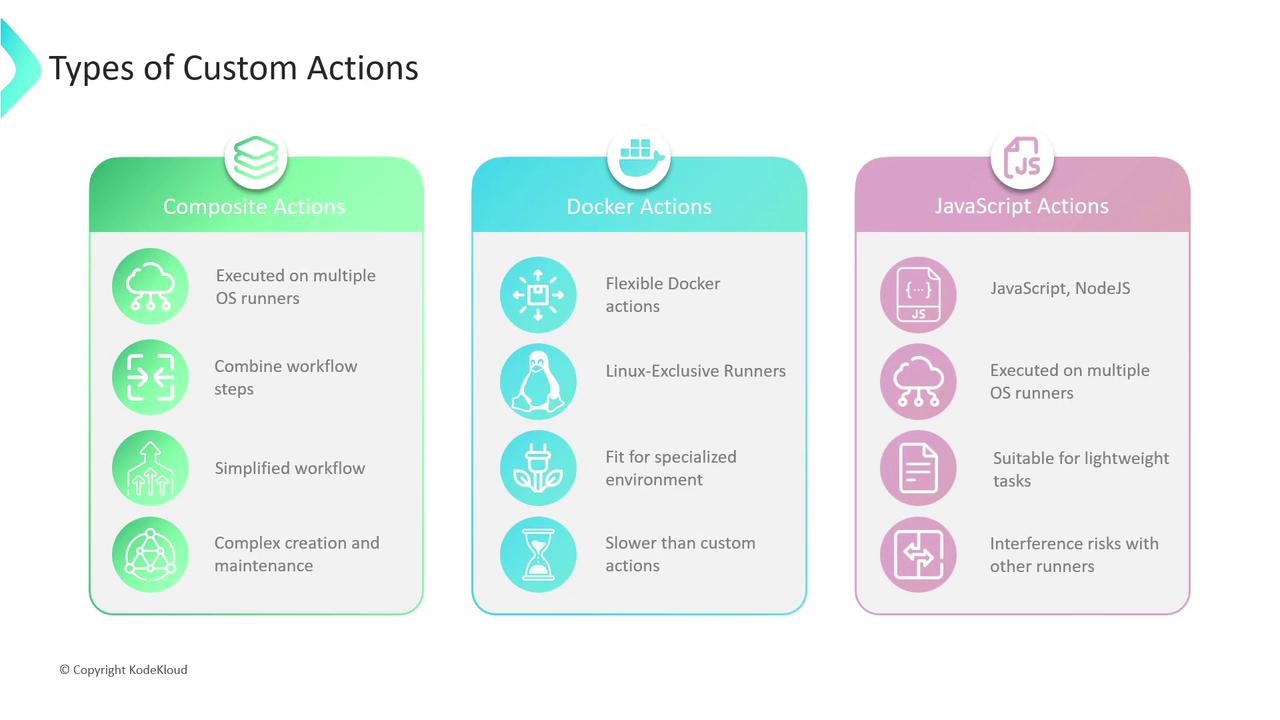GitHub Actions
Custom Actions
What are Custom Actions
Custom GitHub Actions empower you to extend and tailor your CI/CD pipelines beyond the capabilities of community-contributed workflows. By writing your own scripts or containers, you gain full control over specialized tasks, security requirements, and conditional logic.
Why Create Custom Actions?
While the GitHub Marketplace offers a wealth of ready-made solutions—ranging from runtime setup and artifact transfers to Docker builds and Kubernetes deployments—you may still encounter gaps:
- Your project relies on proprietary or legacy systems that public actions don’t support.
- You need to orchestrate multi-step workflows with intricate conditional logic.
- Company policies mandate in-house code for security or compliance reasons.
- Existing actions lack the exact configurations or dependencies your build requires.
Custom actions bridge those gaps, giving you flexibility, reproducibility, and tighter integration with internal tools.
Types of Custom Actions
GitHub supports three primary action types. The table below offers a quick comparison:
| Action Type | Runner Support | Ideal Use Case |
|---|---|---|
| Composite Actions | Linux · macOS · Windows | DRY workflows by grouping steps into one action |
| Docker Container Actions | Linux only | Full OS control & custom dependencies |
| JavaScript Actions | Linux · macOS · Windows | Fast startup & lightweight Node.js scripts |
Composite Actions
Composite actions let you bundle multiple workflow steps into a single, reusable action. They simplify your workflow.yml and promote consistency across repositories.
- Benefits
- Encourages reuse and reduces duplication (DRY).
- No extra runtime environment required.
- Considerations
- Managing complex step dependencies can increase maintenance overhead.
Note
Use composite actions to encapsulate common setup tasks, such as linting or test orchestration, across multiple repositories.
Docker Container Actions
Docker container actions run a customized container image defined by your Dockerfile. This isolates dependencies and environment configurations.
- Pros
- Complete control over OS, libraries, and tools.
- Ideal for builds requiring non-standard system packages.
- Cons
- Adds Docker build and maintenance complexity.
- Slower startup due to container initialization.
Warning
Docker container actions are supported only on Linux runners. Ensure your workflows target the correct OS.
JavaScript Actions
JavaScript (or TypeScript) actions leverage Node.js and the @actions/* toolkit. They run directly on the runner machine for fast initialization.
- Advantages
- Cross-platform support (Linux, macOS, Windows).
- Quick startup and lightweight—perfect for simple I/O tasks.
- Trade-offs
- Less isolation compared to Docker; processes share the host environment.
- Node.js runtime dependency.

Choosing the Right Action
Simple Script vs. Complex Environment
– Use JavaScript actions for quick file operations or API calls.
– Opt for Docker containers when you need specialized system libraries.Cross-Platform Requirements
– Composite and JavaScript actions both support macOS and Windows.
– Docker actions run exclusively on Linux.Maintenance and Reusability
– Composite actions offer the best balance for grouping common steps.
– JavaScript actions scale well for small utility tasks without container overhead.
References
Watch Video
Watch video content